Australia was stripped bare by feral animals. This sanctuary is reversing decades of damage
By Nick O'Malley and Nick Moir
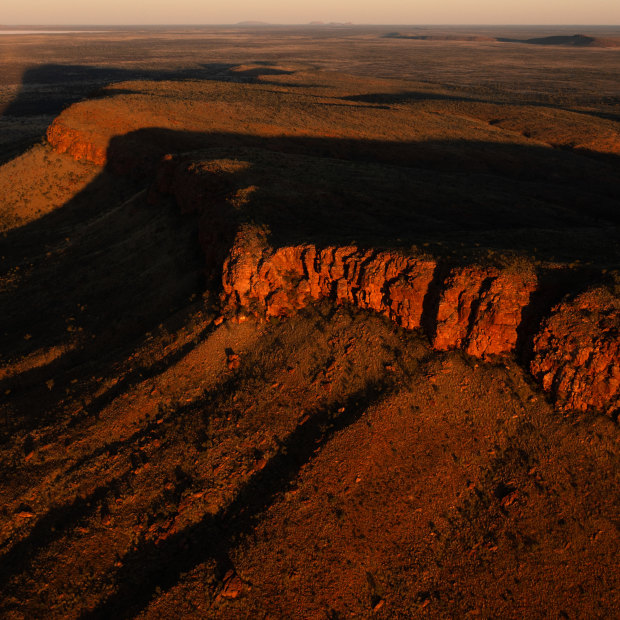
Newhaven, north west of Alice Springs, is a time machine, offering glimpses of an Australia that existed before Europeans arrived.Credit: Nick Moir
At a glance, nothing about the fence makes obvious sense out here, 350 kilometres north-west of Alice Springs on a finger of the Great Sandy Desert that juts from the far west into the Northern Territory’s red earth.
Even if there were cattle grazed out here, the fence is a far more formidable barrier than anything you’ve ever seen on a farm.
It stands 180 centimetres tall and is buttressed at regular intervals with sturdy galvanised iron uprights. Its thick layers of wire netting run into the distance, with a red dirt patrol track meticulously cleared on either side of any brush that might have blown up against it.
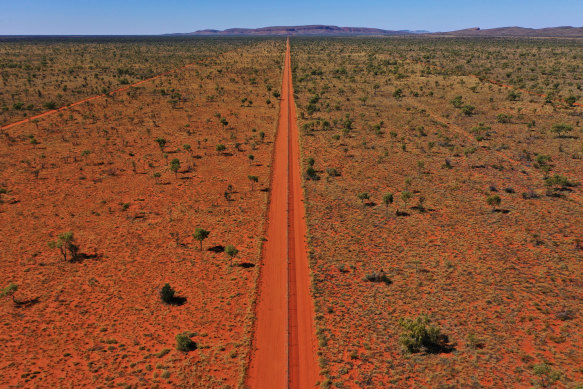
An electric fence is constantly checked and maintained. Credit: Nick Moir
By a locked heavy steel gate that doesn’t swing, but slides on runners embedded in concrete, an energiser bolted to a pole pulses menacingly. It throws 8000 volts along the fence every second. The charge is enough to kill an unlucky person or seriously antagonise a curious camel.
This electronic heartbeat is the only constant sound you’ll hear for miles out here at the Newhaven Wildlife Sanctuary, interrupted mostly by the sad song of the wind in the desert oaks and the howling of dingoes towards dawn.
“The fence in Jurassic Park had 10,000 volts,” Australian Wildlife Conservancy (AWC) ecologist Joey Clarke says as we arrive at the gate in a four-wheel-drive early one morning in late autumn.
“That didn’t end well,” says our photographer, Nick Moir.
This is Newhaven Wildlife Sanctuary, a tract of 262,000 hectares that sprawls around Wartikinpiri, a quartzite bluff forced out of the northern flatlands 350 million years ago to make up part of the West MacDonnell Ranges.
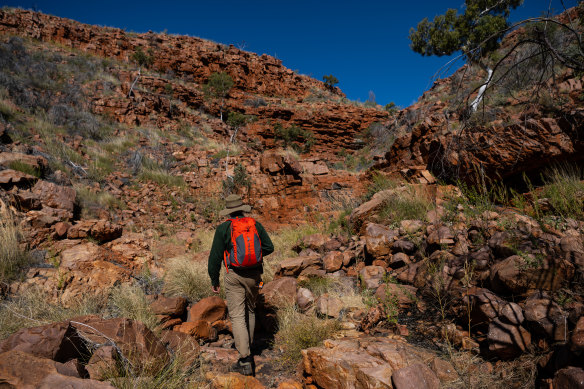
Inside the property is a 10,000-hectare fenced area completely devoid of feral animals including cats and foxes. Credit: Nick Moir
At the heart of it is that thrumming fence which runs for 44 kilometres, encircling 9400 hectares of dunes and spinifex, mulga scrub, saltpans and bloodwoods.
It is hard to exaggerate the significance of the fence. Where once fences were regarded with suspicion by some Australian ecologists – after all a fenced animal is no longer truly a wild one – the work of AWC and other groups has proved that, deployed well, they can be a critical tool to save what is left of the small native mammals whose numbers have crashed across the continent since European settlement.
And as they go up, scientists are discovering it is not just prey mammals that are benefiting. Behind the wires of this growing string of arks across the country, whole ecosystems are stirring back to life.
Something like a time machine is being built, offering glimpses of an Australia that existed before Europeans arrived, and what parts of it might look like again if we can ever remove cats and foxes.
The silence of the possums
Professor John Woinarski, one of the nation’s leading ecologists, remembers the forests he studied falling silent around him. “I was in the Northern Territory for nearly 30 years,” he says.
“When I first went there in the early 1980s and was in the field doing research, it was a wonderland. In camp, you would hear little mammals scampering over the table and chairs if we had left out scraps from dinner.
“Spotlighting you would see possums and sugar gliders, native tree rats and phascogales. These were the animals we were trapping for surveys and in the morning it was so exciting to open the traps and see what we had.
“But over the course of two decades the numbers just kept getting fewer and fewer. We stopped hearing the scuttling and scampering at night.
“Watching the bush fall quiet around us before our eyes was really disheartening.”
What Woinarski was witnessing was the collapse in numbers of small native animals that began the moment cats leapt ashore from the tall ships that carried them from Europe, only to accelerate when the cats were joined by foxes.
While animals in Europe, Africa, Asia and the Americas had evolved alongside predators like these, those of the island nations and Australia had no defence. Some even froze when threatened, a method of self-defence that must have thrilled the first cats that crossed their path.
So rapidly did cats fan out across the country that some European explorers found them established as they arrived in areas new to them, leading to a now disproved theory that some must have arrived with earlier Portuguese visitors to Australia.
Foxes could never take hold in the wet far north, but the cat eventually did.
Newspaper clippings from 1910 show that European settlement of parts of Western Australia was slowed because the ground was so thoroughly honeycombed by burrowing animals that horses kept breaking their fetlocks.
Stripped of First Nations communities that had tended the landscape with fire management and riven by the new predators, the ecosystems began to change rapidly.
It wasn’t just remote Australia that was stripped bare. The last sighting of quolls in Sydney was in Vaucluse’s Nielsen Park in 1963. In Melbourne, it was 1948 in Kew. Once the animals disappeared they were quickly forgotten, a gap in our collective memory that Woinarski attributes to something called shifting baseline syndrome.
Put simply, each generation believes the environment that they grow up with to be normal. A child born the year the last Sydney quoll died will consider their absence normal, even though the animal lived there for millions of years until moments ago.
Shifting baseline syndrome means Australia was able to lose 33 species of its unique mammals – the highest such extinction rate in the world – without a sense of crisis taking hold.
It took outsiders to run with an obvious idea.
John Wamsley was the tradie-turned-mathematician and conservationist who was among the first to build private fenced sanctuaries and kill off the cats and foxes within them to protect native animals. He is best remembered by some for the cat pelt he cheekily wore as a hat when he attended a function to collect an SA Tourism award in 1991.
His vision of a network of fenced sanctuaries across the country failed to take off then, but it did attract the attention of a British financier, Martin Copley. He first visited Australia in 1966 and by 1994 he had moved to Australia permanently and thrown himself into private conservation as he approached retirement.
Copley took advice from Wamsley and, when Wamsley needed to sell off his sanctuaries, he took them on.
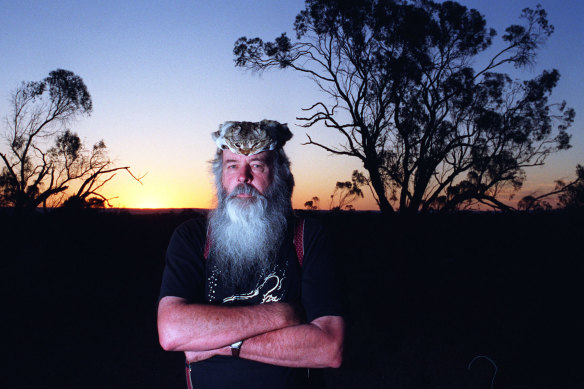
Sanctuary pioneer John Wamsley.Credit: Rick Stevens
An experienced business networker, Copley built and then tapped a list of contacts for donations and took on some high-profile advisers, including Professor Tim Flannery. “My one condition was that he had to follow the science,” says Flannery.
Under the banner of the AWC, the organisation and the land it managed began to expand. What Copley sought was large but affordable areas of potential habitat; land that had been degraded over the years but could be restored to health. Former pastoral leases outside the continent’s comparatively expensive agricultural south-east made obvious sense.
In those early days Flannery would research the land and then lay out the pros and cons of potential sites. Some were islands that had not yet been invaded by cats, some key mainland sites.
Flannery recalls the time he went through the pros and cons of purchasing either Faure Island or Mount Gibson, both in WA. Confronted by the significance of both sites, Copley, he says, paused a moment or two and said: “I suppose we will just have to buy both then.”
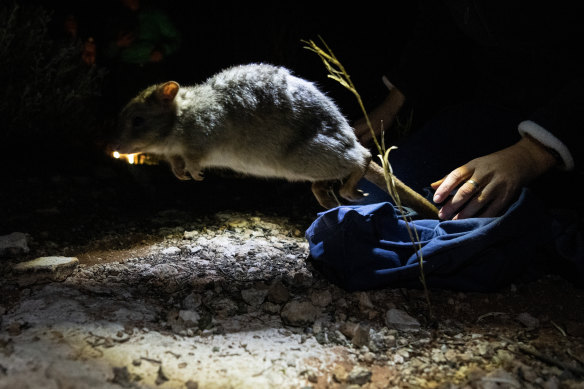
The AWC ecology team catch and record the recently released burrowing bettongs to note their health and numbers. Credit: Nick Moir
Once AWC acquires a new site, a radical intervention begins. The land is intensively managed rather than locked away. Scientists and ecologists move in, supported by experienced volunteers. Surveys are made of which species exist on the sites – native and introduced. Fire and weed management plans are drawn up. Where appropriate, traditional owners are brought on board as collaborators or advisers.
Fences are built and invasive predators exterminated.
Finally, where it is possible, the regionally extinct species that once would have lived inside the wires are found and bred to safe numbers and eventually released, with the new populations exhaustively monitored in their new homes.
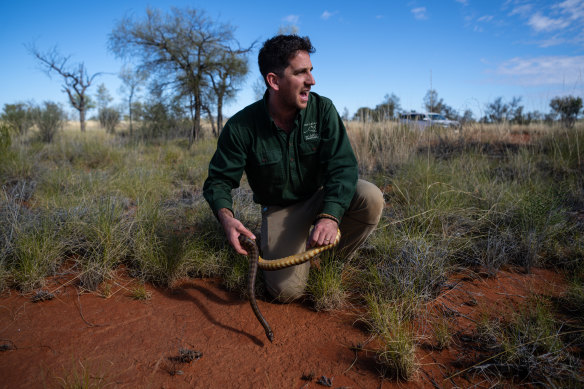
AWC ecologist Joey Clarke with a woma python.Credit: Nick Moir
With fire properly managed and predators kept out, small mammal species typically begin to burrow and forage. The overturned soils are healthier and provide tiny depressions where moisture gathers and seeds are more likely to propagate. Healthier grasses and shrubs attract birds and insects, which in turn boost the number of lizards and snakes.
As we arrive in Newhaven, staff are out burning patches of spinifex, ensuring that the desert growth retains a healthy mosaic pattern so wildfire cannot destroy large areas of growth.
A black kite watches from the bough of a dead bloodwood on a dune and dives for a snake escaping the flame. As it returns to eat its prey, a second kite swoops in and steals it.
Between the kites, the goannas and the snakes, says Professor Sarah Legge, large enough fenced areas can expose animals within them to predation. “It is not a perfect solution, but there are some animals that we know would be extinct if we didn’t have the fences.”
Back from the dead
It’s noon and we are inside a locked indoor enclosure at the Alice Springs Desert Park where Bruce Pascoe, a sturdy bloke in khaki, is showing off the breeding cages that house central rock rats, little pouched hopping rodents with luxuriously furred tails that once lived across central Australia and are now so rare that they have twice been declared extinct.
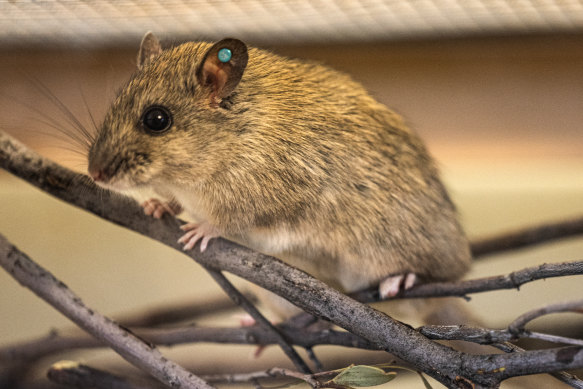
Central rock rats are bred in Alice Springs for an upcoming release into Newhaven. Credit: Nick Moir
“You won’t see one,” Pascoe says bluntly as he talks us through the breeding process and we peer into the cages that line the walls. “They’re in there, but they’re far too shy. There’s not many people who can say they’ve seen one alive.”
“There’s one,” says Clarke.
And there indeed is a fist-sized central rock rat, lazing in a splash of sunlight in its breeding enclosure. She is in no rush either. She appears to be modelling her tail for her guests.
It is at centres like this across the country that much of AWC’s most crucial work is done.
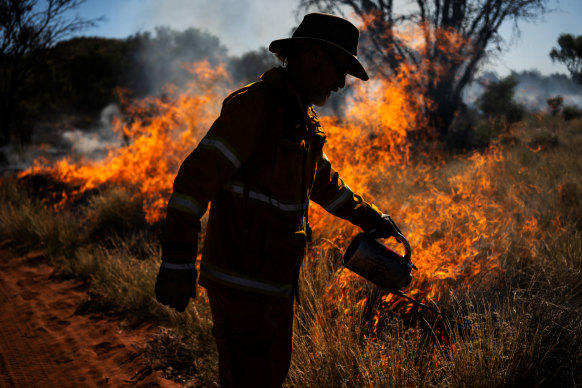
Small prescribed burns remove patchy spinifex in seconds.Credit: Nick Moir
Across the country scientists and volunteers have been hard at work seeking out and capturing animals from populations that have, against the odds, survived the recent invasion.
Some island populations never met the cat or the fox and thrived offshore. Some tiny groups held out in remote strongholds, their numbers dwindling until they were rediscovered even after they were thought lost.
From these holdout populations, safe havens like Newhaven are restocked with the species that once would have called them home.
It’s approaching midnight when Clarke’s scientific poise abandons him completely. He grips my arm, eyes shining beneath a head torch, and says: “I’ve worked for AWC for 10 years and in the past few hours I’ve seen the most critical weight-range endangered animals I have ever seen in a day.”
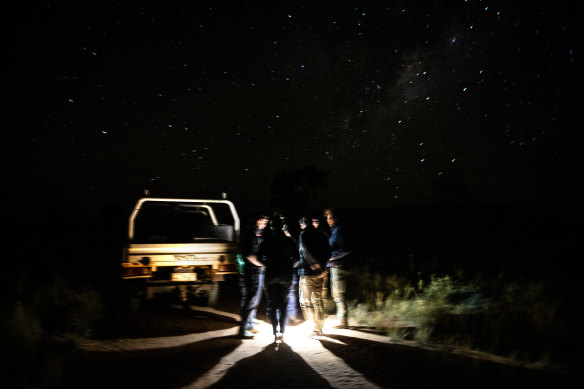
Safe havens like Newhaven are restocked with the species that once would have called them home.Credit: Nick Moir
As the sun set we had wandered from the camp just inside the fence line to the west in the hope of finding some mala. Also known as the rufous hare-wallaby, these tiny macropods, each standing lower than your knee, once lived across the western half of the continent but were hunted to extinction but for a few offshore islands. The AWC bred a rescue population at Scotia, its sanctuary south of Broken Hill, and released 30 into Newhaven in 2019.
We’d been warned not to get our hopes up. Mala, solitary herbivores, are notoriously shy. Another party of guests had left Newhaven days earlier without seeing one. We found our first by a dirt road within minutes. It remained still in a spotlight – bored or scared – as we took photos. A second grazed on the far side of the same road a hundred metres further on, and two more lingered beneath a communications tower.
“You know how rare it is to see a mala?” Clarke asked. Today it is estimated that 446 live inside the fence.
Later in the evening we drive west, to where AWC scientists have left traps in the hope of capturing and running checks on a population of burrowing bettongs. Even smaller than the mala, burrowing bettongs were once Australia’s most common macropod and thrived across WA, SA, western NSW and Victoria, but have also been killed off apart from refuge populations and island holdouts.
The staff are delighted with what they find. The population at Newhaven has reclaimed burrows that had calcified over generations. They are living, says Clarke, in the renovated homes of their ancestors.
The traps are full of thriving animals and the scientists work quickly and quietly to run their health checks and take their measurements. A year ago 65 were released, and it is too soon for significant population growth, though it is believed Newhaven could support 1750 of them.
What we learn that night is that most of the females are carrying young. A hushed cheer breaks out each time a pair of tiny feet are found poking out of a pouch.
In the past, governments have resisted the use of fenced areas as conservation tools – perhaps, says Legge, due to the expense such intensive management demands. Untended fences can be breached, leading to catastrophic losses of our rarest species. Cats and foxes are known to patrol their perimeters.
But the success of the model employed by the AWC and a handful of other private groups has led to their rapid expansion in recent years, including by state governments.
Until we find a way to remove the vast majority of introduced predators, they are the last, best hope for many animals, says Flannery.
One day, though, he hopes we will be able to bring them down.
The Herald’s travel to Newhaven was supported by the Australian Wildlife Conservancy.
Get to the heart of what’s happening with climate change and the environment. Our fortnightly Environment newsletter brings you the news, the issues and the solutions. Sign up here.